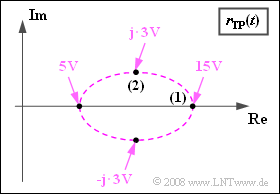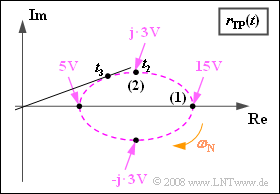Difference between revisions of "Aufgaben:Exercise 2.8: Asymmetrical Channel"
m |
|||
| Line 3: | Line 3: | ||
}} | }} | ||
| − | [[File:P_ID1038__Mod_A_2_8.png|right|frame| | + | [[File:P_ID1038__Mod_A_2_8.png|right|frame|Equivalent low-pass signal <br>in the complex plane]] |
| − | + | A cosine-shaped source signal $q(t)$ with amplitude $A_{\rm N}$ and frequency $f_{\rm N}$ is DSB amplitude modulated, such that the modulated signal is given by: | |
:$$ s(t) = \big[ q(t) + A_{\rm T}\big] \cdot \cos(2 \pi \cdot f_{\rm T} \cdot t ) \hspace{0.05cm}.$$ | :$$ s(t) = \big[ q(t) + A_{\rm T}\big] \cdot \cos(2 \pi \cdot f_{\rm T} \cdot t ) \hspace{0.05cm}.$$ | ||
| − | + | The transmission channel exhibits linear distortions: | |
| − | * | + | *While the lower sideband $($LSB frequency: $f_{\rm T} - f_{\rm N})$ and the carrier are transmitted undistorted, |
| − | * | + | *the upper sideband $($OSB-Frequenz: $f_{\rm T} + f_{\rm N})$ is weighted with the attenuation factor $α_{\rm O} = 0.25$ . |
| − | + | DThe graph shows the locus curve, i.e., the representation of the equivalent low-pass signal $r_{\rm TP}(t)$ in the complex plane. | |
| − | + | Evaluating the signal $r(t)$ with an ideal envelope demodulator, we obtain a sink signal $v(t)$, which can be approximated as follows: | |
:$$v(t) = 2.424 \,{\rm V} \cdot \cos(\omega_{\rm N} \cdot t ) -0.148 \,{\rm V} \cdot \cos(2\omega_{\rm N} \cdot t )+ 0.056 \,{\rm V} \cdot \cos(3\omega_{\rm N} \cdot t )-\text{ ...}$$ | :$$v(t) = 2.424 \,{\rm V} \cdot \cos(\omega_{\rm N} \cdot t ) -0.148 \,{\rm V} \cdot \cos(2\omega_{\rm N} \cdot t )+ 0.056 \,{\rm V} \cdot \cos(3\omega_{\rm N} \cdot t )-\text{ ...}$$ | ||
| − | + | For this measurement, the message frequency $f_{\rm N} = 2 \ \rm kHz$ was used. | |
| − | In | + | In subtask '''(7)''' the signal-to-noise power ratio $\rm (SNR)$ should be calculated as follows: |
:$$ \rho_{v } = \frac{P_{v 1}}{P_{\varepsilon }} \hspace{0.05cm}.$$ | :$$ \rho_{v } = \frac{P_{v 1}}{P_{\varepsilon }} \hspace{0.05cm}.$$ | ||
| − | + | Here, $P_{v1} = α^2 · P_q$ and $P_ε$ denote the "powers" of both signals: | |
:$$ v_1(t) = 2.424 \,{\rm V} \cdot \cos(\omega_{\rm N} \cdot t )\hspace{0.05cm},$$ | :$$ v_1(t) = 2.424 \,{\rm V} \cdot \cos(\omega_{\rm N} \cdot t )\hspace{0.05cm},$$ | ||
:$$ \varepsilon(t) = v(t) - v_1(t) \approx -0.148 \,{\rm V} \cdot \cos(2\omega_{\rm N} \cdot t )+ 0.056 \,{\rm V} \cdot \cos(3\omega_{\rm N} \cdot t ) \hspace{0.05cm}.$$ | :$$ \varepsilon(t) = v(t) - v_1(t) \approx -0.148 \,{\rm V} \cdot \cos(2\omega_{\rm N} \cdot t )+ 0.056 \,{\rm V} \cdot \cos(3\omega_{\rm N} \cdot t ) \hspace{0.05cm}.$$ | ||
| Line 30: | Line 30: | ||
| − | '' | + | ''Hints:'' |
| − | * | + | *This exercise belongs to the chapter [[Modulation_Methods/Envelope_Demodulation|Envelope Demodulation]]. |
| − | * | + | *Particular reference is made to the page [[Modulation_Methods/Envelope_Demodulation#Description_using_the_equivalent_low-pass_signal|Description using the equivalent low-pass signal]]. |
| − | === | + | ===Questions=== |
<quiz display=simple> | <quiz display=simple> | ||
| − | { | + | {Give the low-pass signal $r_{\rm TP}(t)$ in its analytical form. What value results for time $t = 0$? |
|type="{}"} | |type="{}"} | ||
$r_{\rm TP}(t=0) \ = \ $ { 15 3% } $\ \rm V$ | $r_{\rm TP}(t=0) \ = \ $ { 15 3% } $\ \rm V$ | ||
| − | { | + | {What are the amplitude values $A_{\rm T}$ and $A_{\rm N}$? |
|type="{}"} | |type="{}"} | ||
$A_{\rm T} \ = \ $ { 10 3% } $\ \rm V$ | $A_{\rm T} \ = \ $ { 10 3% } $\ \rm V$ | ||
$A_{\rm N} \ = \ $ { 8 3% } $\ \rm V$ | $A_{\rm N} \ = \ $ { 8 3% } $\ \rm V$ | ||
| − | { | + | {Let $f_{\rm N} \hspace{0.15cm}\underline{= 2 \ \rm kHz}$. At which time $t_1$ is the starting point '''(1)''' first reached again after $t = 0$ ? |
|type="{}"} | |type="{}"} | ||
$t_1 \ = \ $ { 0.5 3% } $\ \rm ms$ | $t_1 \ = \ $ { 0.5 3% } $\ \rm ms$ | ||
| − | { | + | {At which point in time $t_2$ is the elliptical point '''(2)''' with value $\rm j · 3\ V$ first reached? |
|type="{}"} | |type="{}"} | ||
$t_2 \ = \ $ { 0.375 3% } $\ \rm ms$ | $t_2 \ = \ $ { 0.375 3% } $\ \rm ms$ | ||
| − | { | + | {Calculate the Sie die Betragsfunktion (Hüllkurve) $a(t)$ und die Phasenfunktion $ϕ(t)$ für diesen Zeitpunkt $t_2$. |
|type="{}"} | |type="{}"} | ||
$a(t = t_2) \ = \ $ { 10.44 3% } $\ \rm V$ | $a(t = t_2) \ = \ $ { 10.44 3% } $\ \rm V$ | ||
Revision as of 21:36, 20 December 2021
A cosine-shaped source signal $q(t)$ with amplitude $A_{\rm N}$ and frequency $f_{\rm N}$ is DSB amplitude modulated, such that the modulated signal is given by:
- $$ s(t) = \big[ q(t) + A_{\rm T}\big] \cdot \cos(2 \pi \cdot f_{\rm T} \cdot t ) \hspace{0.05cm}.$$
The transmission channel exhibits linear distortions:
- While the lower sideband $($LSB frequency: $f_{\rm T} - f_{\rm N})$ and the carrier are transmitted undistorted,
- the upper sideband $($OSB-Frequenz: $f_{\rm T} + f_{\rm N})$ is weighted with the attenuation factor $α_{\rm O} = 0.25$ .
DThe graph shows the locus curve, i.e., the representation of the equivalent low-pass signal $r_{\rm TP}(t)$ in the complex plane.
Evaluating the signal $r(t)$ with an ideal envelope demodulator, we obtain a sink signal $v(t)$, which can be approximated as follows:
- $$v(t) = 2.424 \,{\rm V} \cdot \cos(\omega_{\rm N} \cdot t ) -0.148 \,{\rm V} \cdot \cos(2\omega_{\rm N} \cdot t )+ 0.056 \,{\rm V} \cdot \cos(3\omega_{\rm N} \cdot t )-\text{ ...}$$
For this measurement, the message frequency $f_{\rm N} = 2 \ \rm kHz$ was used.
In subtask (7) the signal-to-noise power ratio $\rm (SNR)$ should be calculated as follows:
- $$ \rho_{v } = \frac{P_{v 1}}{P_{\varepsilon }} \hspace{0.05cm}.$$
Here, $P_{v1} = α^2 · P_q$ and $P_ε$ denote the "powers" of both signals:
- $$ v_1(t) = 2.424 \,{\rm V} \cdot \cos(\omega_{\rm N} \cdot t )\hspace{0.05cm},$$
- $$ \varepsilon(t) = v(t) - v_1(t) \approx -0.148 \,{\rm V} \cdot \cos(2\omega_{\rm N} \cdot t )+ 0.056 \,{\rm V} \cdot \cos(3\omega_{\rm N} \cdot t ) \hspace{0.05cm}.$$
Hints:
- This exercise belongs to the chapter Envelope Demodulation.
- Particular reference is made to the page Description using the equivalent low-pass signal.
Questions
Musterlösung
- $$ r_{\rm TP}(t) = A_{\rm T} + \frac{A_{\rm N}}{2} \cdot \alpha_{\rm O} \cdot{\rm e}^{{\rm j} \cdot \hspace{0.03cm}\omega_{\rm N}\cdot t} + \frac{A_{\rm N}}{2} \cdot{\rm e}^{-{\rm j} \cdot \hspace{0.03cm}\omega_{\rm N}\cdot t}\hspace{0.05cm}.$$
- Zum Zeitpunkt $t = 0$ zeigen alle Vektoren in Richtung der reellen Achse.
- Somit kann aus der Grafik auf der Angabenseite $r_{\rm TP}(t = 0)\hspace{0.15cm}\underline { = 15 \ \rm V}$ abgelesen werden.
(2) Die Trägeramplitude ist durch den Ellipsenmittelpunkt festgelegt: $A_{\rm T}\hspace{0.15cm}\underline { = 10 \ \rm V}$.
- Aus der in der ersten Teilaufgabe angegebenen Gleichung kann somit auch die Amplitude $A_{\rm N}$ berechnet werden:
- $$ \frac{A_{\rm N}}{2} \cdot ( 1+ \alpha_0) = r_{\rm TP}(t= 0) - A_{\rm T} = 5 \,{\rm V}\hspace{0.3cm} \Rightarrow \hspace{0.3cm}A_{\rm N} \hspace{0.15cm}\underline {= 8 \,{\rm V}} \hspace{0.05cm}.$$
- Zur Kontrolle kann der in der Grafik markierte Punkt (2) herangezogen werden:
- $$\frac{A_{\rm N}}{2} \cdot ( 1- \alpha_0) = 3 \,{\rm V}\hspace{0.3cm} \Rightarrow \hspace{0.3cm}A_{\rm N} = 8 \,{\rm V} \hspace{0.05cm}.$$
(3) Die für einen Umlauf benötigte Zeit $t_1$ ist gleich der Periodendauer des Quellensignals, also
- $$t_1= 1/f_{\rm N} \hspace{0.15cm}\underline {=0.5 \ \rm ms}.$$
(4) Da das USB größer ist als das OSB, bewegt sich die Spitze des Zeigerverbundes auf der Ellipse im Uhrzeigersinn.
- Der Punkt (2) wird zum Zeitpunkt $t_2 = 3/4 · t_1\hspace{0.15cm}\underline { = 0.375 \ \rm ms}$ zum ersten Mal erreicht.
(5) Die Zeigerlänge zur Zeit $t_2$ kann mit dem Satz von Pythagoras bestimmt werden:
- $$ a(t = t_2) = \sqrt{(10 \,{\rm V})^2 + (3 \,{\rm V})^2}\hspace{0.15cm}\underline { = 10.44 \,{\rm V}}\hspace{0.05cm}.$$
- Für die Phasenfunktion gilt:
- $$\phi(t = t_2) = {\rm arctan} \frac{3 \,{\rm V}}{10 \,{\rm V}} \hspace{0.15cm}\underline {= 16.7^{\circ}}\hspace{0.05cm}.$$
- Die maximale Phase $ϕ_{\rm max}$ ist geringfügig größer. Sie tritt (mit positivem Vorzeichen) zum Zeitpunkt $t_3 < t_2$ dann auf, wenn eine Gerade vom Koordinatenursprung die Ellipse tangiert.
- Durch Aufstellen der Ellipsengleichung kann dieser Punkt $(x_3$, $y_3)$ analytisch exakt berechnet werden.
- Daraus würde für die maximale Phase gelten: $\phi_{\rm max} = {\rm arctan} \ {y_3}/{x_3} \hspace{0.05cm}.$
(6) Die Klirrfaktoren zweiter und dritter Ordnung können aus der angegebenen Gleichung für $v(t)$ $($gültig für $f_{\rm N} = 2 \ \rm kHz)$ ermittelt werden und lauten:
- $$ K_2 = \frac{0.148 \,{\rm V}}{2.424 \,{\rm V}} = 0.061, \hspace{0.3cm} K_3 = \frac{0.056 \,{\rm V}}{2.424 \,{\rm V}} = 0.023 \hspace{0.05cm}.$$
- Damit erhält man für den Gesamtklirrfaktor:
- $$K = \sqrt{K_2^2 + K_3^2 }\hspace{0.15cm}\underline { \approx 6.6 \%}.$$
(7) Für die Leistungen von Nutz– und Störsignal erhält man:
- $$ P_{v 1} = \frac{(2.424 \,{\rm V})^2}{2} = 2.94 \,{\rm V}^2\hspace{0.05cm},\hspace{0.3cm} P_{\varepsilon} = \frac{(-0.148 \,{\rm V})^2}{2} + \frac{(0.056 \,{\rm V})^2}{2}= 0.0125 \,{\rm V}^2\hspace{0.05cm}$$
- Damit ergibt sich für das Signal–zu–Stör–Leistungsverhältnis $\rm (SNR)$:
- $$\rho_{v} = \frac{P_{v 1}}{P_{\varepsilon }}= \frac{(2.94 \,{\rm V})^2}{0.0125 \,{\rm V}^2} \hspace{0.15cm}\underline {\approx 230} = \frac{1}{K^2} \hspace{0.05cm}.$$
- Würde man dagegen die Amplitudenverfälschung ebenfalls dem Fehlersignal zuweisen, so käme man zu einem deutlich kleineren $\rm SNR$.
- Mit $P_q = A_{\rm N}^2/2 = 8 \ \rm V^2$ und $P_{\varepsilon}\hspace{0.02cm}' = \overline{(v(t)-q(t))^2} = {1}/{2}\cdot ( 4 \,{\rm V} - 2.424 \,{\rm V})^2 + P_{\varepsilon}= 1.254 \,{\rm V}^2$ würde man dann erhalten:
- $$\rho_{v }\hspace{0.02cm}' = \frac{8 \,{\rm V}^2}{1.254 \,{\rm V}^2} \approx 6.4\hspace{0.05cm}.$$
(8) Alle Berechnungen gelten unabhängig von der Nachrichtenfrequenz $f_{\rm N}$, wenn der Dämpfungsfaktor des OSB weiterhin $α_{\rm O} = 0.25$ beträgt.
- Damit erhält man auch für $f_{\rm N} = 4 \ \rm kHz$ den gleichen Klirrfaktor $K\hspace{0.15cm}\underline { \approx 6.6 \%}$.

